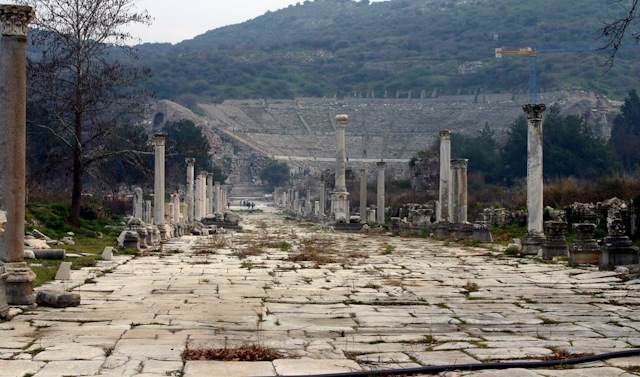The ancient Ephesus witnessed the rise and fall of several remarkable civilizations, two of the most important being the Hellenistic and Roman cultures. While both the Roman Empire and the Hellenistic Empire were significant in ancient history, they differed in several key aspects. Here are ten significant differences between Roman Ephesus and Hellenistic Ephesus;

Founding and Early History
- Hellenistic Ephesus was established in the 4th century BCE by Lysimachus, one of Alexander the Great’s generals, on an earlier settlement going back to prehistoric dates.
- Roman Ephesus continued to thrive under Roman rule after the Roman Republic’s influence in the region. Ephesus in the Roman era was more of an upgrade on an existing city in the same area.
Cultural Influence
- Hellenistic Ephesus was developed under the influence of Greek culture and Hellenistic traditions.
- Roman Ephesus continued to exhibit Greek cultural elements but also absorbed Roman customs and architectural styles. Also, great influences of Hebrew and Egyptian cultures can be seen in Roman Ephesus too.
Architectural Development
- Hellenistic Ephesus showcased classical Greek architecture styles with structures like the Temple of Artemis, one of the Seven Wonders of the Ancient World, and the agoras of Ephesus.
- Roman Ephesus hosted Roman-style buildings, including the Library of Celsus and the Roman theater, showcasing a blend of Roman and Greek architectural elements but gradually becoming all-Roman.
Economic Prosperity
- Hellenistic Ephesus flourished as a trade center with its strategic location by the Aegean Sea, participating in the Hellenistic economic network of the Aegean and Mediterranean seas.
- Roman Ephesus continued to be an important economic hub. Roman Ephesus became much richer, benefiting from Roman infrastructure developments such as roads and harbors.
Administrative Changes
- Hellenistic Ephesus was once a part of the Seleucid Empire and later the Attalid Kingdom before coming under Roman influence. Hellenistic Ephesus never became an administrative center.
- Roman Ephesus became the capital of the Roman province of Asia, signifying a shift in administrative control and importance of Roman Ephesus.
Religious Practices
- Hellenistic Ephesus had The Temple of Artemis, dedicated to the Greek goddess Artemis, was a prominent religious center during this period. Ephesus then was the center of Greek Pagan philosophy.
- Roman Ephesus eventually adapted to Roman religious practices, with the cult of the emperor gaining significance alongside traditional Greek deities. Later, Roman Ephesus slowly became the regional center of Christianity.
Social Structure
- Hellenistic Ephesus had a social structure influenced by Hellenistic ideals and the division between citizens and non-citizens.
- Roman Ephesus had the Roman class system, including citizens and non-citizens, and a big addition of trader class people.
Expansion and Urban Planning
- Hellenistic Ephesus expanded during the Hellenistic period, with a well-planned grid system for its streets, and the city covered a huge area in between two hills.
- Roman Ephesus experienced further urban development and expansion under Roman rule, with improved infrastructure and public buildings. Also, Roman Ephesus expanded outside the city walls, which made the city much bigger.
Theater and Entertainment
- Hellenistic Ephesus hosted a Hellenistic theater for performances and events, which is the base of Ephesus Grand Theater today.
- Roman Ephesus upgraded the old Hellenistic theater into a grand Roman theater, reflecting changes in architectural style and entertainment preferences. Roman Grand Theater is still being used today.
Language
- Hellenistic Ephesus had Greek as the common language used for administration and communication.
- Roman Ephesus had Latin as the primary language, though Greek remained important.
The marriage of Hellenistic and Roman cultures in Ephesus illustrates the dynamic interplay of historical forces, showcasing the adaptability and resilience of human civilization. Ephesus today waits for your visit, from the cosmopolitan vibrancy of Hellenistic Ephesus to the pragmatic engineering marvels of the Roman Empire.
Visit Ephesus With Professional Local Ephesian Tour Guide
Ephesus showcases great cultural and architectural examples of both Hellenistic and Roman eras. There are far more many stories to be unraveled in Ephesus. Contact me to learn more about Ephesus and to hire a local Ephesian tour guide for Ephesus.